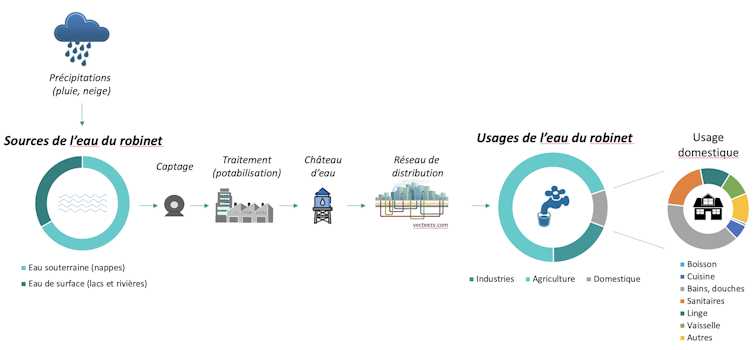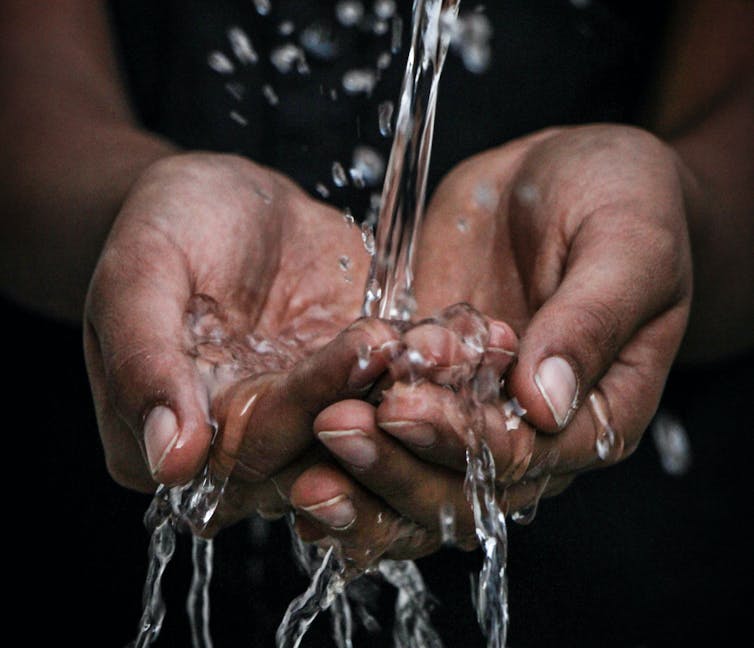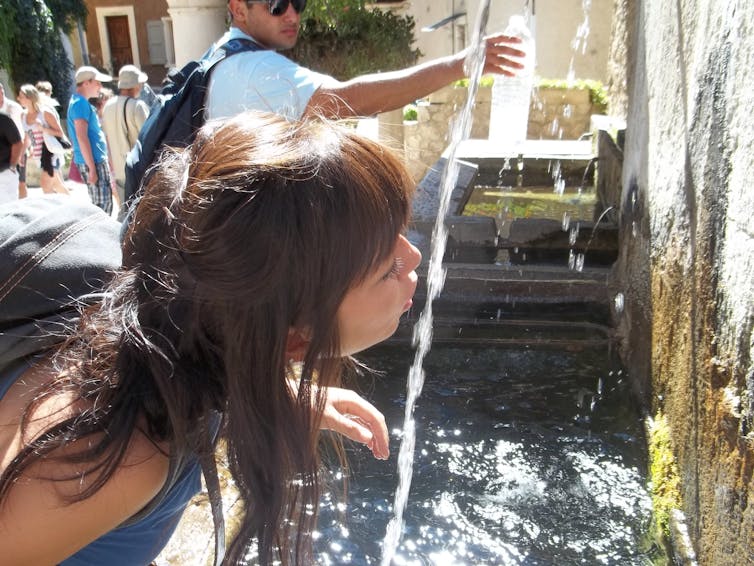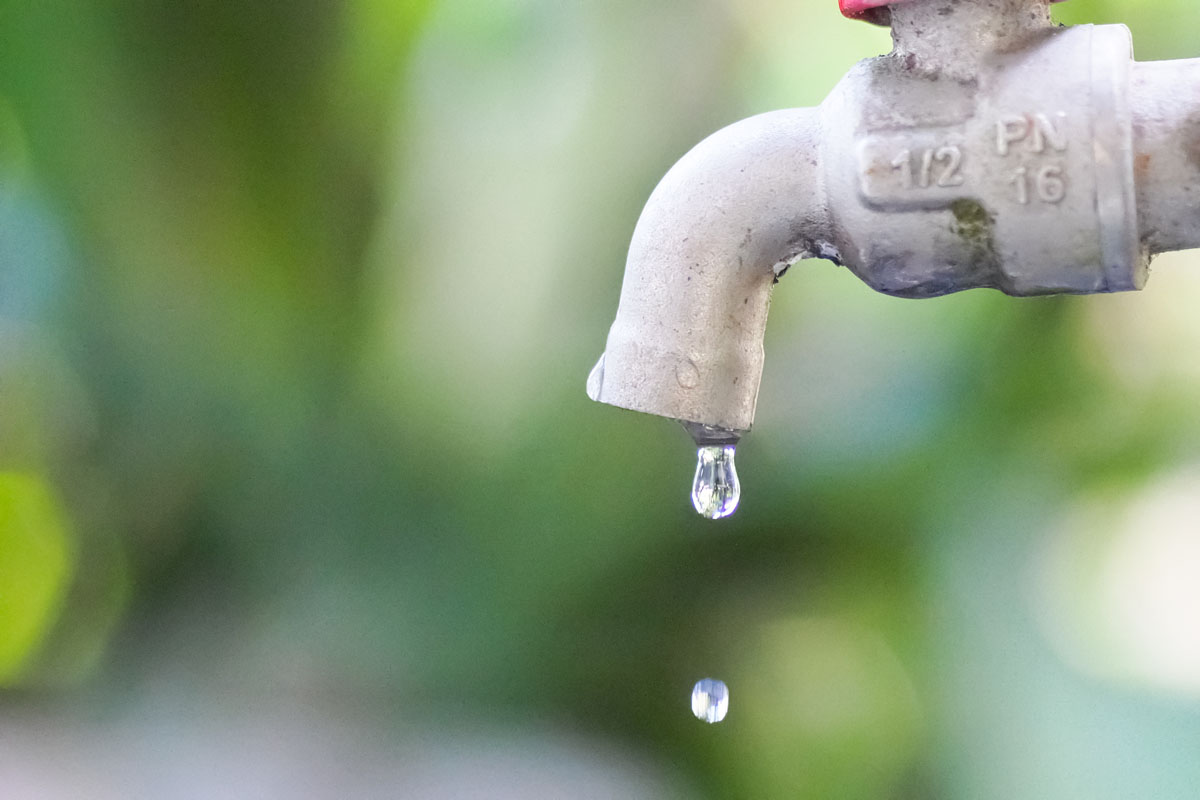Where does tap water come from? How is its quality assured?
In France, turning on a tap to obtain drinking water is a particularly easy everyday gesture, giving us access to water of excellent microbiological quality - which can be very useful, especially in the summer heat... Yet, in 2020, one in three French people continued to drink bottled water rather than tap water, despite the fact that plastic waste is harmful to health and the environment, that bottled water is more expensive... and that its quality is not always beyond reproach. Let's take a look at where tap water comes from and what makes it safe to drink.
Alice Schmitt, University of Montpellier and Julie Mendret, University of Montpellier
Where does running water come from and how does it become drinkable?
Two-thirds ofour drinking water comes from groundwater, while the remaining third comes from surface water (rivers, lakes and dams). Groundwater and rivers are fed by precipitation in the form of snow and rain, and by runoff and infiltration.
Human activities such as agriculture and livestock farming, and their consequences such as deforestation, the destruction of wetlands and climate change, are causing significant changes in this cycle, and particularly in the flows of water transported.

Alice Schmitt and Julie Mendret, Provided by the author
Once captured, the water is sent to a potabilization plant for treatment. The treatment applied depends on the initial quality of the captured water. For groundwater, in three quarters of cases, simple physical treatment (filtration and decantation) and disinfection are sufficient.
For surface waters, more extensive physical and chemical treatments are required - depending on the quality of the water to be treated. In some cases, a refining treatment using ozonation, activated carbon and/or membrane filtration is applied in addition, to remove as much of the remaining dissolved organic matter and micropollutants (pesticides, etc.) as possible.
Disinfection is then always carried out in the final treatment stage, most often by adding chlorine, which has a long-lasting disinfectant effect that maintains excellent water quality during storage in reservoirs and up to distribution.
In France, average per capita consumption of drinking water is estimated at around 150 liters per day, of which 93% is used for hygiene (including 20% for sanitary facilities) and 7% for food. Domestic use accounts for 20% of overall consumption: 35% of drinking water is used for industry and electricity and 45% for agriculture, although it is not necessarily necessary to use drinking water. The reuse of treated wastewater is still very limited in France, due to strict regulations, and remains in the minority for these uses.
A highly regulated water supply
Once treated, the water distributed must meet certain health standards defined in the French Public Health Code, and its quality is regularly monitored from the outlet of the drinking water treatment plants, at the water towers where it is stored, and throughout the distribution network.
[Nearly 70,000 readers trust The Conversation newsletter to better understand the world's major issues. Subscribe today]
In all, some sixty parameters are monitored via bacteriological, physico-chemical, organoleptic and radiological quality limits and references, making tap water themost closely monitored foodstuff in France.
Overall, the quality of urban tap water is excellent in France, where almost 100% of municipalities with more than 50,000 inhabitants and 98% of the total population consumed water of very good microbiological quality all year round in 2020.

mrjn Photography/Unsplash, CC BY
In 2020, 94% of the French population consumed water that complied with regulatory limits all year round. However, as the exceedances detected were limited in concentration and time, it was almost never necessary to restrict tap water consumption.
The long-term health risk of low-dose pesticide consumption is still poorly understood, but highly probable, particularly for sensitive populations such as children and pregnant women.
Occasional problems can arise in very small communities (fewer than 500 inhabitants); in rural areas with intensive agriculture such as monocultures or vineyards using pesticides; in areas near livestock farms, where nitrates can be present in significant quantities; or in areas near certain industries.
If standards are exceeded, it is the responsibility of the production or distribution manager to take the necessary corrective measures to restore water quality.
Exceptional derogations can be put in place (in the absence of any health risk, and with a requirement for rapid compliance), or strict measures can be applied very quickly if necessary by the Prefect, following theopinion of the corresponding Regional Health Agency - for example, a restriction on use, or even a temporary ban on consumption, as in Châteauroux in June.
The presence of a water safety management plan, indicating the measures to be taken in the event of a problem, will be mandatory by 2027 thanks to the recast of the "Drinking Water" Directive of December 16, 2020.
Why use tap water rather than bottled water?
France consumes a lot of bottled water, the result of lobbying by brands who have convinced the French that bottled water is better than tap water.

Erica Ashleson, Flickr, CC BY
First and foremost, it's about preserving the environment, since mineral water involves the use of plastic bottles and caps as containers. Most of this waste (87%) ends up in the environment as plastic pollution, having a major impact on aquatic flora and fauna. Sorting this waste in appropriate centers doesn't solve everything, since only a quarter of plastic waste is actually recycled on a global scale. A study on the life-cycle analysis of mineral water showed that its environmental impact was sometimes 1,000 times greater than that of tap water.
But it's also a public health issue, linked to the presence of microplastics in water. They are mainly due to the degradation of larger plastic objects such as bottles. Every week, we ingest the equivalent of a plastic credit card, mainly through the water we drink - both tap and bottled - but also to a lesser extent through the food we eat, particularly shellfish, and the air we breathe (this is an average estimated worldwide, not just in France).
Reducing or even eliminating the use of plastic, in particular by no longer consuming bottled water, would reduce the presence of microplastics in the oceans.
What's more, some highly mineralized bottled waters should be consumed only occasionally, and are not recommended for daily use. To neutralize the potentially unpleasant taste of tap water due to chlorine, which in no way affects its sanitary quality, a very simple solution is to let it breathe by leaving it in the fridge for a few hours before drinking.
It's also important to point out that bottled water, taken from underground resources, also contains minute quantities of pollutants such as pesticides and medicines.
Finally, drinking bottled water (1.5 liters per person per day) is at least 100 times more expensive than tap water.
In France, we're lucky enough to have high-quality tap water, so let's make the most of it, for the sake of our planet and our health! You can find the average quality of water in your commune on your annual bill or the consult online at any time.![]()
Alice Schmitt, Post-doctoral fellow in Process Engineering, European Membrane Institute, University of Montpellier and Julie Mendret, Senior Lecturer, HDR, University of Montpellier
This article is republished from The Conversation under a Creative Commons license. Read theoriginal article.
